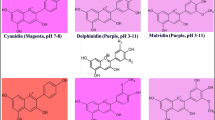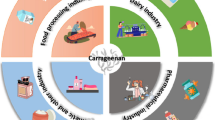Abstract
Gibberellic acid (GA3) inhibition of anthocyanin accumulation by carrot cell-suspension cultures was reversed by supplying dihydroquercitin or naringenin to the culture and not by supplying 4-coumaric acid or malonic acid. This suggested that gibberellic acid was inhibiting chalcone synthase, chalcone isomerase, or acetyl CoA carboxylase. Acetyl-CoA-carboxylase specific activity was the same in GA3-treated and untreated cultures and was not detected in cultures treated with uniconazole, an inhibitor of gibberellic acid biosynthesis. Chalcone-isomerase specific activity was lower in GA3-treated cultures than in untreated cultures and was lower in uniconazole-treated cultures than in the GA3-treated cultures. The total chalcone synthase activity in extracts from GA3- and from uniconazole-treated cells was not significantly different from that in extracts of untreated tissue. When these extracts were chromatographed on a Mono Q column, three peaks of chalcone synthase activity were found in extracts of nontreated cells, whereas only two of these peaks were detected in extracts of GA3-treated cells. The extracts from GA3-treated cells did not contain the peak of chalcone synthase activity that, in untreated cells, preceded the main peak. The correlation between the absence of this peak and the inhibition of anthocyanin accumulation suggests that this form of chalcone synthase is responsible for anthocyanin synthesis and that GA3 prevents this form from appearing in the cells.
Similar content being viewed by others
References
Cheng CL, Wetherell DF, Dougall DK (1985) 4-Coumarate CoA ligase in wild carrot cell culture clones which accumulates different amounts of anthocyanin. In: Newmann KH, Barz W, Reinhard E (eds) Metabolism of plant cell cultures. Springer-Verlag, Berlin, pp. 87–98
Dougall DK, Frazier GC (1989) Nutrient utilization during biomass and anthocyanin accumulation in suspension cultures of wild carrot cells. Plant Cell Tiss Org Cult 18:95–104
Dougall DK, Weyraugh KW (1980) Growth and anthocyanin production by carrot suspension cultures grown under chemostat conditions with phosphate as a limiting nutrient. Biotechnol Bioeng 22:337–352
Gleitz J, Seitz HU (1989) Induction of chalcone synthase in cell suspension cultures of carrot (Daucus carota) by ultraviolet light: Evidence for two different forms of chalcone synthase. Planta 179:323–330
Hinderer W, Petersen M, Seitz HU (1984) Inhibition of flavonoid biosynthesis by gibberellic acid in cell suspension cultures of Daucus carota L. Planta 160:544–549
Hinderer W, Seitz HU (1985) Chalcone synthase from cell cultures of Daucus carota L. Archiv Biochem Biophys 240:265–272
Hinderer W, Seitz HU (1986) In vitro inhibition of carrot chalcone synthase by 3′-nucleotidase: The role of the 3′-phosphate group of malonyl CoA in flavonoid biosynthesis. Archiv Biochem Biophys 246:217–224
Ilan A, Dougall DK (1992) The effect of growth retardants on anthocyanin production in carrot cell suspension cultures. Plant Cell Rep 11:304–309
Ilan A, Zanewich KP, Rood SB, Dougall DK (1994) Gibberellic acid decreases anthocyanin accumulation in wild carrot cell suspension cultures but does not alter 3′ nucleotidase activity. Physiol Plant 92:47–52
Moustafa E, Wong E (1967) Purification and properties of chalcone-flavanone isomerase from soya bean seed. Phytochemistry 6:625–632
Stadman ER (1957) Preparation and assay of acyl coenzyme A and other thiol esters; use of hydroxylamine. In: Colowick SP, Kaplan NO (eds) Methods in enzymology, vol 3. Academic Press, New York, pp 931–941
Stockigt J, Zenk MH (1975) Chemical synthesis and properties of hydroxycinnamoyl coenzyme A derivatives. Z Naturforsch 30c:352–358
Stumpf PK (1976) Lipid metabolism. In: Bonner J, Varner JE (eds) Plant biochemistry. Academic Press, New York, pp 427–461
van Tunen AJ, Koes RE, Spelt CE, van der Krol AR, Stuitje AR, Mol JNM (1988) Cloning of the two chalcone flavanone isomerase genes from Petunia hybrida: Coordinate, light regulated and differential expression of flavonoid genes. EMBO J 7:1257–1263
van Tunen AJ, Mur LA, Bronus GS, Rienstra JD, Koes RE, Mol JNM (1990) Pollen and anther specific chalcone isomerase promoters from petunia: Tandem promoter regulation of the chiA gene. Plant Cell 2:393–401
Vogelien DL, Hrazdina G, Reeves S, Dougall DK (1990) Phenotypic differences in anthocyanin accumulation among clonally related cultures cells of carrot. Plant Cell Tiss Org Cult 22:213–222
Wurtele ES, Nikolau BJ (1990) Plants contain multiple biotin enzymes: Discovery of 3′-methylcrotonyl CoA carboxylase, propionyl CoA carboxylase and pyruvate carboxylase in the plant kingdom. Archiv Biochem Biophys 278:179–186
Author information
Authors and Affiliations
Rights and permissions
About this article
Cite this article
Ilan, A., Dougall, D.K. Effects of gibberellic acid and uniconazole on the activities of some enzymes of anthocyanin biosynthesis in carrot cell cultures. J Plant Growth Regul 13, 213–219 (1994). https://doi.org/10.1007/BF00226039
Received:
Accepted:
Issue Date:
DOI: https://doi.org/10.1007/BF00226039




